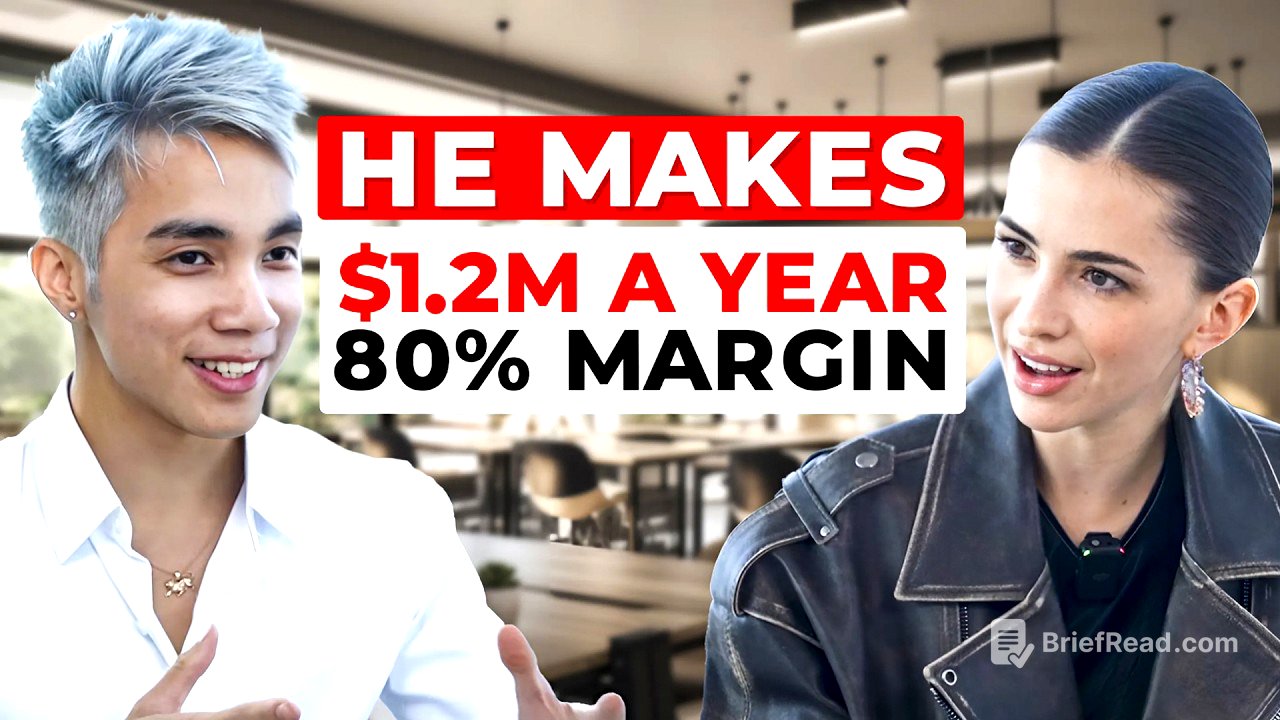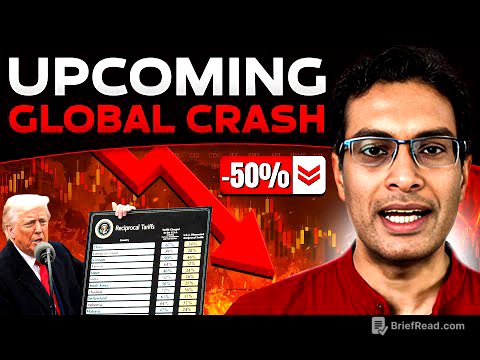TLDR;
This video features an interview with Jake Tran, a successful YouTuber who runs multiple faceless channels. He shares his journey, strategies, and insights on building a media empire on YouTube. He emphasizes the importance of creating a system for content creation, delegating tasks, and diversifying channels to mitigate risks. Arvid Ali, Jake's advisor, also provides valuable advice on automating YouTube businesses and managing expenses.
- Creating a system for content creation is crucial for scaling and avoiding burnout.
- Delegating tasks to a team allows for efficient content production and diversification.
- Diversifying channels reduces risk and provides more opportunities for content creation.
- Vetting brand deals and focusing on quality content are essential for maintaining audience trust.
- Finding a strong "why" is key to overcoming challenges and achieving success on YouTube.
Meet Jake Tran [0:00]
Jake Tran is a popular YouTuber and entrepreneur known for running multiple faceless YouTube channels. His content focuses on political power, the dark sides of big businesses, jerk crime, and scams. The interviewer expresses admiration for Jake's ability to cover American issues from an immigrant's perspective, citing his video on the problem of food served in American schools as an example. She is particularly interested in Jake's processes for building a faceless channel, as she believes it could be a valuable resource and marketing tool for her language learning company.
How long has he been doing his channels? [1:39]
Jake estimates he's been running his Jake Tran Channel for about three or four years. He started with a traditional on-camera personal brand channel but realized that he would quickly run out of content based solely on his own experiences. This led him to transition to faceless channels focused on researched topics and storylines, ensuring a constant stream of video ideas and avoiding the burnout that many on-camera YouTubers experience.
How it all began [3:55]
Jake shares that he had several channels before his current one, including a "cringey" high school attempt that he has since removed. He recalls being inspired by the channel Linus Tech Tips, with its large office, filming sets, and production team. However, he is now grateful he didn't follow that path, as it seems like a "giant headache."
The book that changed his life. [4:36]
Jake credits the book "Blue Ocean Strategy" with changing his life and approach to YouTube. The book teaches how to enter crowded niches and create a unique space with less competition. He applied this strategy by analyzing different niches on YouTube, such as personal finance and video essays, and combining elements he liked while removing those he didn't. This resulted in a unique channel that filled a gap in the market, where viewers had few other options for similar content. He created his own niche where viewers really only had him to go to.
He also shares that he watched a documentary on fractional Reserve banking and how sketchy the world of banking is, so he made a video on the Absurd business of banking.
Criticism of his content. What was his reaction to that? [7:33]
Jake acknowledges criticism regarding clickbait headlines and a perceived decrease in content quality due to reduced personal involvement. He also addresses controversy surrounding brand deals, particularly after being called out by Coffeezilla. While the criticism "didn't feel good," he admits there were things he could have done better. As a result, he has improved the vetting process for brand deals to ensure they align with his values and maintain audience trust.
How does he select topics for videos? [8:52]
Jake explains that he selects topics for his videos through a mix of sources. He has a network of people who suggest video ideas, and he also gets ideas from advisors like Arvid Ali.
Meeting Arvid Ali [9:19]
Arvid Ali, who was the president of Jordan Belford The Wolf of Wall Street, reached out to Jake as a fan of his videos. Arvid, who has worked with celebrities and advises wealthy individuals, noticed Jake was working long hours and suggested he needed to create a system to scale his channel.
I need to find a way to create a system that creates the videos for me [11:08]
Arvid Ali advised Jake to create a system, similar to McDonald's, that would allow others to produce videos while maintaining quality. He explained that Jake was like a small burger shop owner who believed no one could make videos as well as he could, which would lead to burnout and limit his ability to scale his income. Jake initially resisted this idea but eventually followed Arvid's advice and began outsourcing the production of his videos.
How does he work with the team? [12:20]
Jake started delegating by hiring an audio editor, which saved him about an hour a week. Next, he hired a video editor and trained them gradually, starting with the easiest parts of the video, such as the 30-second on-camera clip at the end. Once he was confident in their abilities, he slowly scaled up their responsibilities to include the entire video. He repeated this process for the rest of the production, including thumbnails and research. He hires people all over the world.
Jake avoids relying on a single "Jack of all trades" and instead builds a team of specialists. He trains writers from scratch, teaching them how to create captivating intros and tell stories effectively.
Does he have any other channels? [17:12]
In addition to the Jake Tran Channel with 1.8 million subscribers, Jake has launched two other channels. He is most excited about "Evil Food Supply," a documentary channel exposing the problems with the food system, which is growing rapidly. He also launched a third channel called "How to Get Away With It."
Risks of having multiple channels [19:00]
Having multiple channels reduces risk by not being entirely dependent on one channel. It also allows for easier video idea generation and posting, as videos can be spread across different channels. Jake uses his main channel for experimentation, while the other channels have their own set of videos.
Top sources monetizing channels [20:53]
Jake identifies sponsors (brand deals) as the top source of income for his channels, followed by AdSense and YouTube memberships. For his main channel, members pay $5 a month for access to private documentaries that are too controversial to be posted publicly, such as those on Jeffrey Epstein and MK Ultra.
The advice to people who are starting YouTube channel [22:00]
Jake advises aspiring YouTubers to remember that creating videos is not impossible and that anyone can do it. The key to success is having a strong "why" – a deep-seated motivation that will push them through challenges. For Jake, this was growing up poor and wanting to take care of his parents and prove doubters wrong.
I decided to jump on a call with Arvid to ask him all the questions [24:07]
Arvid Ali elaborates on his recommendation for Jake to build a McDonald's-type system, emphasizing that many creators mistakenly believe they are irreplaceable. He suggests taking a phased approach to automating a YouTube business. First, focus on outsourcing backend operations like research and script writing. Then, gradually reduce on-camera involvement by incorporating other people or voiceovers. Finally, identify channels that can feature other experts or guests.
What's the ballpark figure for like producing one video if we find people internationally? [28:09]
Arvid recommends keeping expenses below 50% of revenue. He suggests hiring people internationally from countries like Indonesia, Bangladesh, and South Africa, where $7-8 per hour is a good wage. He notes that these individuals are often very trainable and receptive to feedback. Eastern Europe is a good source for thumbnail designers, who charge around $25-30. He estimates that a good video can be produced for a few hundred dollars, with a maximum of $1,000. He advises testing multiple candidates for each role and providing specific feedback to improve their performance.









